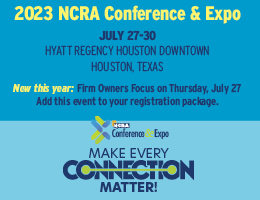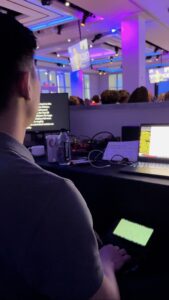 Once you are armed with NCRA’s certified CART provider designation, what else do you need to consider as you venture into business for yourself? CART is being used in many diverse venues as either an onsite or remote service, and there are costs, as well as various hardware and software issues, associated with each that you need to take into account.
Once you are armed with NCRA’s certified CART provider designation, what else do you need to consider as you venture into business for yourself? CART is being used in many diverse venues as either an onsite or remote service, and there are costs, as well as various hardware and software issues, associated with each that you need to take into account.
In an on-site classroom setting, students can view CART many different ways. Obviously, the student can sit next to the CART provider, but that is considered “old school.” It is what I did more than 15 years ago. A student can now use a tablet or netbook to receive CART on a variety of software programs, and the CART provider can be sitting anywhere in the classroom, sending the CART via Internet to the student using a portable device. If an Internet connection is not available, the CART provider can bring a portable router or a hotspot. Companies such as StenoCast, some CAT vendors, and Text on Top have devices built just for this type of setting. For onsite CART, I also consider how much time I need to travel and to set up and break down my equipment. A two-hour minimum rate is common in these situations.
If an onsite job requires the CART feed to be projected, some fun new features are available. Some CAT software will allow a specialized CART window that can be shared with the projector so that CART providers can be working in their own CART window, and the consumers will not see what the providers are doing. Text on Top will insert text on top of a PowerPoint — similar to the look of captioning. And, boy, what is available now with projectors is amazing. Even some smartphones can be set up to work as projectors! The CART provider needs to know what is expected in this setting ahead of time and not be blindsided at the last minute. Again, take into consideration travel and setup time.
In a remote CART setting, I love that I have so many different options for delivery, such as Adobe Acrobat, Blackboard, StreamText, 1CapApp, and many others. On my end, I need a stable Internet connection and a way to receive audio. Again, there are many options, such as Skype, AOL, or a phone connection. The options seem to grow exponentially! Another option could be as simple as screen sharing with Skype. It depends on the situation and the consumer. Check with your CAT software as to what specific settings would work best. The majority of remote CART projects are billed at an hourly rate, taking into consideration the cost of third-party software.
Some other costs of doing business are not obvious, such as E&O insurance, liability insurance, business insurance, redundant equipment, and software support contracts. And once you’ve acquired your certification, you must maintain your CEUs, and the cost of attending conventions or other educational offerings can add up.
Without getting too deep into specifics, here are a few other things that need to be considered as you develop your rate:
- Your level of overall experience and certification;
- The going rate in your area for onsite CART; if no one is available, privately consult with a working CART provider nearby; and
- For remote CART, again, privately consult with working CART providers to see what the average for this type of work is; where you live would not come into play here.
On a final note, as a CART provider, be ready to be faced with that age-old question: “Isn’t this the old-fashioned way? Why not use voice recognition?” Frankly, CART is the best voice recognition. It offers consumers the best accuracy rate, includes speaker identifications and background noises, which are lost or garbled by voice recognition, and offers the possibility of receiving an immediate transcript. You are your own best advocate. Be prepared for the questions you will certainly receive, asking why this method should be used, and be armed with facts and solid reasons why you are the best, most current way to provide realtime translation.
After considering the time, effort, hardware, software, and education you have invested, you certainly don’t want to sell yourself short!
JCR Contributing Editor Deanna P. Baker, RMR, is a captioner and CART provider in Flagstaff, Ariz. She can be reached at dpbaker@mindspring.com.







